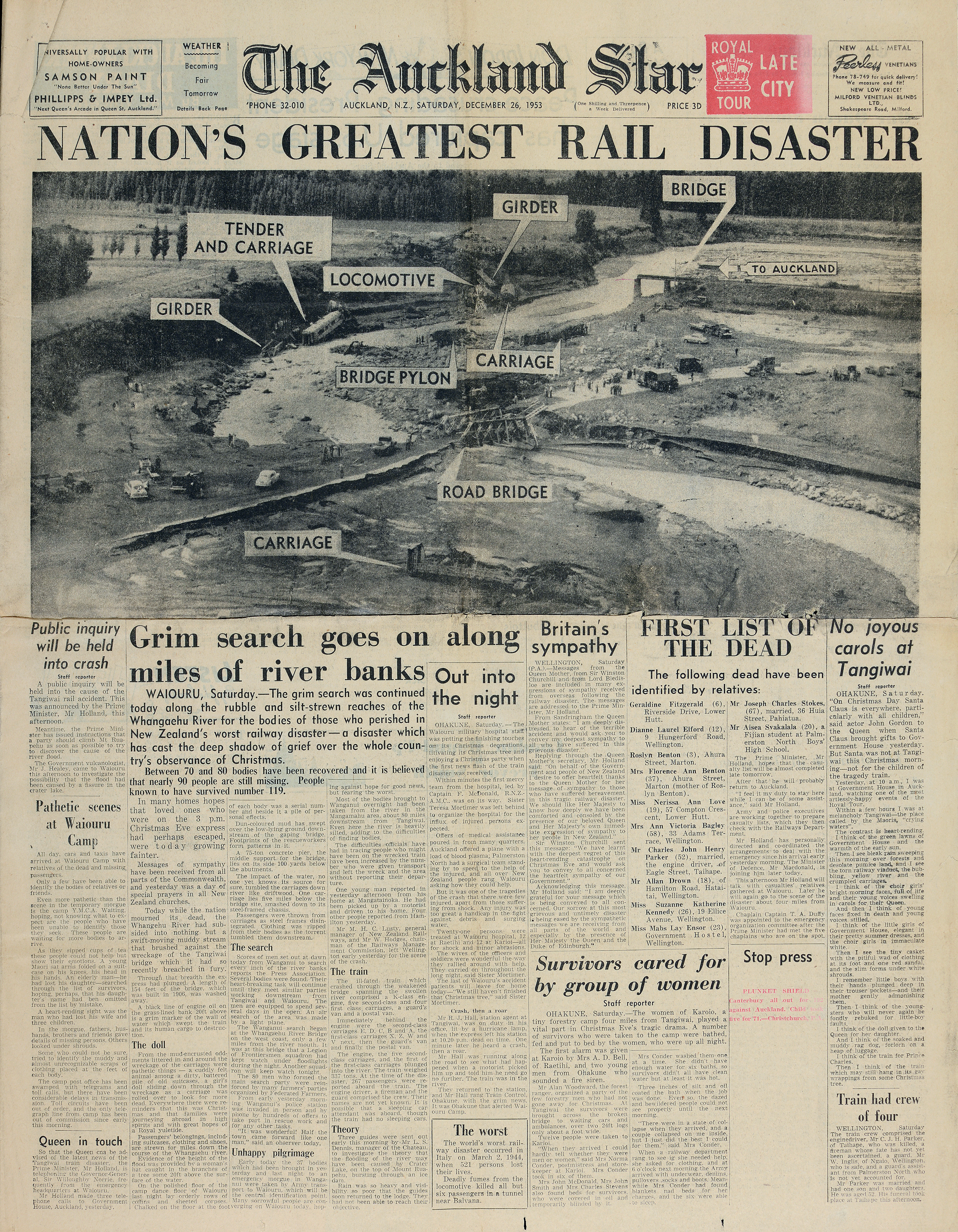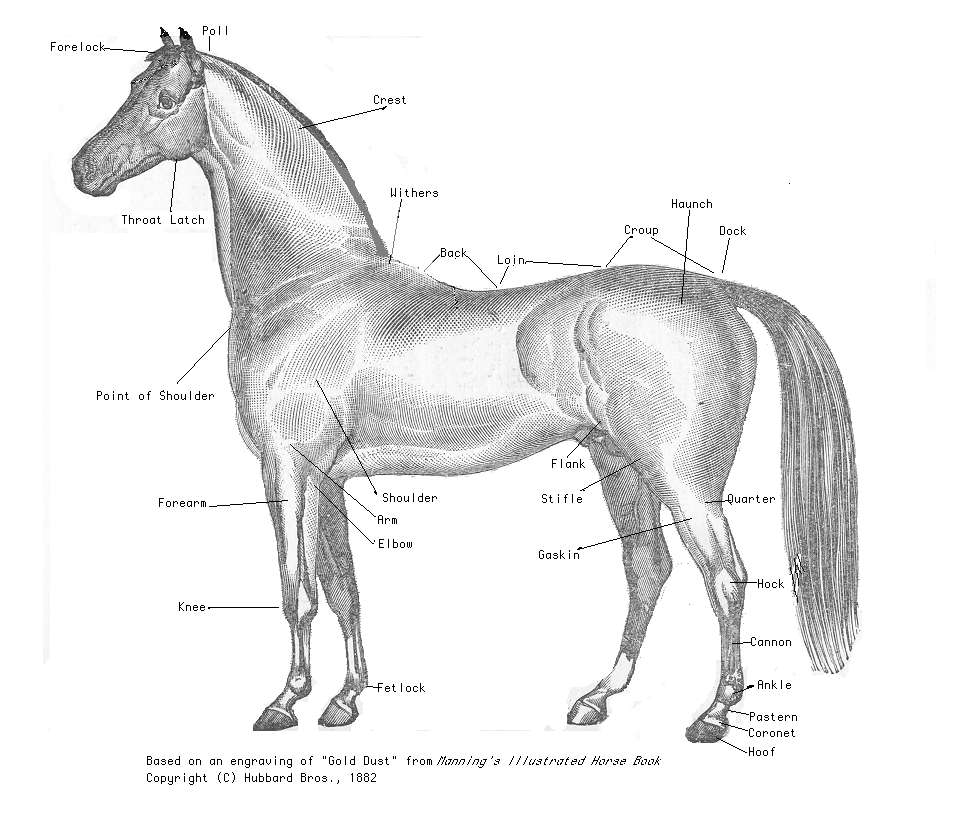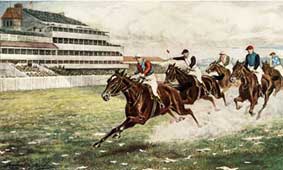|
Ladas (horse)
Ladas (1891–1914) was a British Thoroughbred racehorse and sire. His career attracted an unusual amount of attention as his owner, Lord Rosebery, became Prime Minister of the United Kingdom at the height of his success. In a career that lasted from 1893 to 1894, Ladas ran eleven times and won seven races. He was the leading British two-year-old of 1893, being unbeaten in four starts including the Champagne Stakes and the Middle Park Stakes. In the following year, he won the 2000 Guineas at Newmarket and the Derby at Epsom to complete the first two legs of the English Triple Crown. He was beaten by the four-year-old colt Isinglass in his next two starts and failed in his bid for the Triple Crown when beaten in the St Leger at Doncaster. Ladas was retired to stud at the end of the season, and sired the winners of several important races. He died in 1914. Background Ladas was a bay horse of almost faultless conformation, standing just under 16 hands high. He was bred ... [...More Info...] [...Related Items...] OR: [Wikipedia] [Google] [Baidu] |
Emil Adam
Emil Franz Adam (20 May 1843, in Munich – 19 January 1924, in Munich) was a German equestrian painter. Life Adam was the son of animal painter Benno Adam. He initially intended to devote himself to science, but, carried away by the example of his grandfather, the equestrian painter Albrecht Adam, he decided to be a painter. He studied painting under the guidance of his uncle, the painter Franz Adam, and later under Jean-François Portaels in Brussels. He became one of the last great masters in depicting horses, horse portraits and hunting scenes. Adam married Josephine Marie, née Wurmb. They had two sons, the painter Richard Benno Adam (1873–1937) and the priest Ernst Adam (1884-1955). Adam's work consisted primarily of horse paintings, equestrian portraits, and hunting scenes. He was invited, along with his father to Pardubice, Bohemia, in 1867, to paint the hunting club members portrait, a group of 60 people. Gallery File:Emil Adam St Galmier.jpg, St Galmier Fi ... [...More Info...] [...Related Items...] OR: [Wikipedia] [Google] [Baidu] |
Horse Breeding
Horse breeding is reproduction in horses, and particularly the human-directed process of selective breeding of animals, particularly purebred horses of a given breed. Planned matings can be used to produce specifically desired characteristics in domesticated horses. Furthermore, modern breeding management and technologies can increase the rate of conception, a healthy pregnancy, and successful foaling. Terminology The male parent of a horse, a stallion, is commonly known as the ''sire'' and the female parent, the mare, is called the ''dam''. Both are genetically important, as each parent genes can be existent with a 50% probability in the foal. Contrary to popular misuse, "colt" refers to a young male horse only; "filly" is a young female. Though many horse owners may simply breed a family mare to a local stallion in order to produce a companion animal, most professional breeders use selective breeding to produce individuals of a given phenotype, or breed. Alternatively, a ... [...More Info...] [...Related Items...] OR: [Wikipedia] [Google] [Baidu] |
Buckinghamshire
Buckinghamshire (), abbreviated Bucks, is a ceremonial county in South East England that borders Greater London to the south-east, Berkshire to the south, Oxfordshire to the west, Northamptonshire to the north, Bedfordshire to the north-east and Hertfordshire to the east. Buckinghamshire is one of the Home Counties, the counties of England that surround Greater London. Towns such as High Wycombe, Amersham, Chesham and the Chalfonts in the east and southeast of the county are parts of the London commuter belt, forming some of the most densely populated parts of the county, with some even being served by the London Underground. Development in this region is restricted by the Metropolitan Green Belt. The county's largest settlement and only city is Milton Keynes in the northeast, which with the surrounding area is administered by Milton Keynes City Council as a unitary authority separately to the rest of Buckinghamshire. The remainder of the county is administered by Bu ... [...More Info...] [...Related Items...] OR: [Wikipedia] [Google] [Baidu] |
Mentmore And Crafton Studs
Mentmore Stud and Crafton Stud were thoroughbred horse breeding operations that were part of the Mentmore Towers estate on the Bedfordshire and Buckinghamshire borders, England. The Crafton stud farm is located at Crafton, Buckinghamshire, approximately one mile from Mentmore Towers and was founded circa 1850 by Baron Mayer de Rothschild. The most notable horses from this era included Rothschild's founding stallion King Tom and his offspring Favonius and Hannah who between them won the Epsom Derby, 1,000 Guineas, Oaks, and St Leger in 1871. Mentmore Stud was built between 1913 and 1914 by Archibald Primrose, 5th Earl of Rosebery to complement his nearby stud farm at Crafton which he had acquired through his 1878 marriage to Baron Mayer de Rothschild's daughter Hannah. The first two stallions to stand at Mentmore were Cicero and Neil Gow. The 5th Earl won The Derby three times with Crafton-bred horses at Ladas, Sir Visto, and Cicero. In 1929 both Crafton and Mentmo ... [...More Info...] [...Related Items...] OR: [Wikipedia] [Google] [Baidu] |
Auckland Star
The ''Auckland Star'' was an evening daily newspaper published in Auckland, New Zealand, from 24 March 1870 to 16 August 1991. Survived by its Sunday edition, the ''Sunday Star'', part of its name endures in '' The Sunday Star-Times'', created in the 1994 merger of the ''Dominion Sunday Times'' and the ''Sunday Star''. Originally published as the ''Evening Star'' from 24 March 1870 to 7 March 1879, the paper continued as the ''Auckland Evening Star'' between 8 March 1879 and 12 April 1887, and from then on as the ''Auckland Star''. One of the paper's notable investigative journalists was Pat Booth, who was responsible for notable coverage of the Crewe murders and the eventual exoneration of Arthur Allan Thomas. Booth and the paper extensively reported on the Mr Asia case. In 1987, the owners of the ''Star'' launched a morning newspaper to more directly compete with ''The New Zealand Herald''. The ''Auckland Sun'' was affected by the 1987 stock market crash and folded a year ... [...More Info...] [...Related Items...] OR: [Wikipedia] [Google] [Baidu] |
Hand (unit)
The hand is a non- SI unit of measurement of length standardized to . It is used to measure the height of horses in many English-speaking countries, including Australia, Canada, the Republic of Ireland, the United Kingdom, and the United States. It was originally based on the breadth of a human hand. The adoption of the international inch in 1959 allowed for a standardized imperial form and a metric conversion. It may be abbreviated to "h" or "hh". Although measurements between whole hands are usually expressed in what appears to be decimal format, the subdivision of the hand is not decimal but is in base 4, so subdivisions after the radix point are in quarters of a hand, which are inches. Thus, 62 inches is fifteen and a half hands, or 15.2 hh (normally said as "fifteen-two", or occasionally in full as "fifteen hands two inches"). Terminology "Hands" may be abbreviated to "h", or "hh". The "hh" form is sometimes interpreted as standing for "hands high". When spoken ... [...More Info...] [...Related Items...] OR: [Wikipedia] [Google] [Baidu] |
Equine Conformation
Equine conformation evaluates a horse's bone structure, musculature, and its body proportions in relation to each other. Undesirable conformation can limit the ability to perform a specific task. Although there are several faults with universal disadvantages, a horse's conformation is usually judged by what its intended use may be. Thus "form to function" is one of the first set of traits considered in judging conformation. A horse with poor form for a Grand Prix show jumper could have excellent conformation for a World Champion cutting horse, or to be a champion draft horse. Every horse has good and bad points of its conformation and many horses (including Olympic caliber horses) excel even with conformation faults. Conformation of the head and neck The standard of the ideal head varies dramatically from breed to breed based on a mixture of the role the horse is bred for and what breeders, owners and enthusiasts find appealing. Breed standards frequently cite large eyes, a b ... [...More Info...] [...Related Items...] OR: [Wikipedia] [Google] [Baidu] |
Stud (animal)
A stud animal is a registered animal retained for breeding. The terms for the male of a given animal species (stallion, bull, rooster, etc.) usually imply that the animal is intact—that is, not castrated—and therefore capable of siring offspring. A specialized vocabulary exists for de-sexed animals (gelding, steer, etc.) and those animals used in grading up to a purebred status. Stud females are generally used to breed further stud animals, but stud males may be used in crossbreeding programs. Both sexes of stud animals are regularly used in artificial breeding programs. A stud farm, in animal husbandry, is an establishment for selective breeding using stud animals.Taylor, Peter, Pastoral Properties of Australia, George Allen & Unwin, Sydney, London, Boston,1984 This results in artificial selection. Stud fees A stud fee is a price paid by the owner of a female animal, such as a horse or a dog, to the owner of a male animal for the right to breed to it. Service fees can ... [...More Info...] [...Related Items...] OR: [Wikipedia] [Google] [Baidu] |
Doncaster Racecourse
Doncaster Racecourse (also known as the Town Moor course) is a racecourse in Doncaster, South Yorkshire, England. It hosts two of Great Britain's 36 annual Group 1 flat races, the St Leger Stakes and the Racing Post Trophy. History Doncaster is one of the oldest (and the largest in physical capacity) established centres for horse racing in Britain, with records of regular race meetings going back to the 16th century. A map of 1595 already shows a racecourse at Town Moor. In 1600 the corporation tried to put an end to the races because of the number of ruffians they attracted, but by 1614 it acknowledged failure and instead marked out a racecourse. Doncaster is home to two of the World's oldest horse races: The Doncaster Cup The earliest important race in Doncaster's history was the Doncaster Gold Cup, first run over Cantley Common in 1766. The Doncaster Cup is the oldest continuing regulated horse race in the world. Together with the Goodwood Cup and Ascot G ... [...More Info...] [...Related Items...] OR: [Wikipedia] [Google] [Baidu] |
Isinglass (horse)
Isinglass (1890–1911) was a British Thoroughbred racehorse and sire. In a career which lasted from 1892 until 1895 he ran twelve times and won eleven races. He was the best British two-year-old of 1892 and went on to become sixth winner of the English Triple Crown by winning the 2000 Guineas at Newmarket, The Derby and the St. Leger Stakes at Doncaster in the following year. He was undefeated in his last two seasons, setting a world record for prize money and gaining recognition from contemporary experts as one of the best horses seen in England up to that time. Background Isinglass was a powerfully-built bay horse standing 16 hands high, bred by his owner Harry McCalmont. He was sired by the double Ascot Gold Cup winner Isonomy out of a mare named Deadlock. Deadlock had a varied career, having been once sold for £20 and working as a carriage-horse before being bought by McCalmont. Isinglass was trained at the stable of James Jewitt, who had previously trained the ... [...More Info...] [...Related Items...] OR: [Wikipedia] [Google] [Baidu] |
Colt (horse)
A colt is a male horse, usually below the age of four years. Description The term "colt" only describes young male horses and is not to be confused with foal, which is a horse of either sex less than one year of age. Similarly, a yearling is a horse of either sex between the ages of one and two. A young female horse is called a filly, and a mare once she is an adult animal. In horse racing, particularly for Thoroughbreds in the United Kingdom, a colt is defined as an uncastrated male from the age of two up to and including the age of four. The term is derived from Proto-Germanic *''kultaz'' ("lump, bundle, offspring") and is etymologically related to "child." An adult male horse, if left intact, is called either a " stallion" if used for breeding, or a horse (sometimes full horse); if castrated, it is called a gelding. In some cases, particularly informal nomenclature, a gelding under four years is still called a colt. A rig or ridgling is a male equine with a retained ... [...More Info...] [...Related Items...] OR: [Wikipedia] [Google] [Baidu] |
Triple Crown Of Thoroughbred Racing
The Triple Crown of Thoroughbred Racing, often shortened to Triple Crown, is a series of horse races for Thoroughbreds, often restricted to three-year-olds. Winning all three of these Thoroughbred horse races is considered the greatest accomplishment in Thoroughbred racing. The term originated in mid-19th-century England and nations where Thoroughbred racing is popular each have their own Triple Crown series. English Triple Crowns In England, where the term Triple Crown originated with West Australian's three wins in 1853, it is made up of: # The 2,000 Guineas Stakes, run over 1 mile (1,609 metres) at Newmarket Racecourse in Newmarket, Suffolk # The Derby, run over 1 mile 4 furlongs and 10 yards (2,423 metres) at Epsom Downs Racecourse in Epsom, Surrey # The St Leger Stakes, run over 1 mile 6 furlongs and 132 yards (2,937 metres) at Town Moor in Doncaster, Yorkshire Since the 2,000 Guineas was first run in 1809, fifteen horses (including three winners of substitute races a ... [...More Info...] [...Related Items...] OR: [Wikipedia] [Google] [Baidu] |
.jpg)


.jpg)




